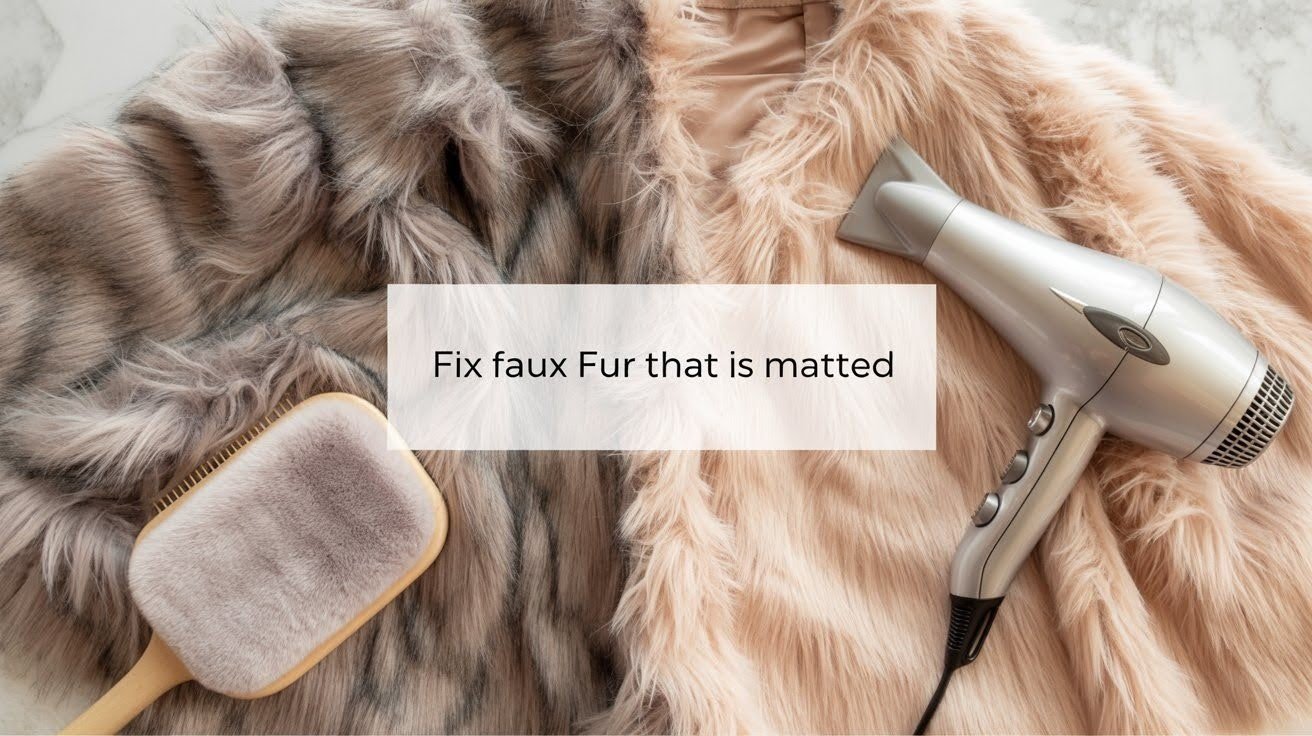I get it you love your faux fur jacket, but it’s looking a bit rough around the edges. Maybe it’s matted, dirty, or just doesn’t feel as soft as when you first bought it.
Faux fur has become incredibly popular because it gives you that luxurious look without harming animals. But here’s the thing: this synthetic material needs special care to stay looking good.
I’ve been caring for faux fur items for years, and I’ve learned what works (and what definitely doesn’t). Trust me, I’ve made the mistakes so you don’t have to.
In this guide, I’ll show you exactly how to clean, store, and maintain your faux fur pieces. You’ll learn why regular care matters, what products to use, and simple techniques that keep your items looking fresh.
What is Matted Faux Fur?
When synthetic fur fibers clump together and lose their fluffy texture, creating flat, tangled patches.

Definition and appearance
Matted faux fur happens when the synthetic fibers get twisted and stuck together. Instead of standing up straight and fluffy, they lay flat against the fabric base.
You’ll notice these areas look compressed and dull. The fur loses its bounce and starts to resemble felt more than fur. It’s not pretty, and it definitely doesn’t feel luxurious anymore.
How to identify matted areas (texture, appearance, feel)
Spotting matted sections is pretty straightforward. Here’s what to look for:
Run your fingers through the fur. Matted areas feel rough and bumpy instead of smooth. The fibers won’t separate easily when you try to fluff them.

Visually, these spots appear darker and flatter than the rest of the garment. They often occur around collars, cuffs, and anywhere the fur rubs against itself or other surfaces.
Press gently on different areas. Healthy faux fur springs back quickly. Matted sections stay compressed and feel dense under your touch.
Common Reasons Faux Fur Becomes Matted
Understanding why faux fur mats helps you prevent damage and keep your items looking their best.

Improper Storage
I see this mistake all the time. People stuff their faux fur coats into tiny closet spaces or pile heavy items on top of them.
When you cram faux fur into tight spots, the fibers get crushed and can’t maintain their shape. That constant pressure forces them to bend and stick together permanently.
Heavy jackets or boxes sitting on your faux fur create the same problem. The weight flattens the fibers until they forget how to stand up straight.
Exposure to Heat
Heat is faux fur’s worst enemy. I learned this the hard way when I left my jacket too close to a heater.
Blow dryers, direct sunlight, and heating vents can actually melt the synthetic fibers. Once they melt, they fuse together and create those stubborn matted patches.
Even moderate heat over time causes the fibers to lose their flexibility and clump together.
Contact with Moisture
Water and humidity wreak havoc on faux fur. The fibers absorb moisture and swell, then stick to each other as they dry.
Rain, snow, or even high humidity days can leave your faux fur looking flat and tangled. The wet fibers lose their shape and bond together.
Friction and Regular Use
The more you wear your faux fur, the more it rubs against your clothes, bags, and seat belts.
This constant friction causes the fibers to tangle and mat, especially in high-contact areas like under your arms or around the collar.
How to Fix Faux Fur That is Matted
A step-by-step process to restore your matted faux fur back to its original fluffy condition.
Step 1: Initial Assessment

Before I start any repair work, I always take a good look at what I’m dealing with.
Lay your garment on a flat surface and examine it closely. Look for matted spots, tears, or areas where the fur has completely flattened.
Make mental notes of the worst problem areas. This helps me focus my efforts where they’re needed most.
Step 2: Check the Care Label

I can’t stress this enough – always read that little tag first. Some faux fur items have specific cleaning requirements that could save you from disaster.
The manufacturer knows their product best. Following their instructions prevents you from accidentally damaging the fibers further.
If the label says “dry clean only,” stop here and take it to a professional.
Step 3: Gentle Cleaning

Start with a clean, damp sponge and a tiny drop of mild detergent. I’m talking baby shampoo or gentle fabric cleaner here.
Gently blot the matted areas – don’t rub or scrub. Rubbing makes the matting worse.
Use another clean, damp sponge to blot away any soap residue. You want the fur slightly damp, not soaking wet.
Step 4: Detangling Preparation

Here’s my secret weapon: hair conditioner. Apply a small amount to the matted areas and work it in gently with your fingers.
Let it sit for about 10-15 minutes. The conditioner softens the fibers and makes them easier to separate.
This step is crucial for stubborn mats that won’t budge otherwise.
Step 5: Brushing the Faux Fur

Get yourself a slicker brush or wide-tooth comb. I prefer slicker brushes because they’re gentler on synthetic fibers.
Start at the very tips of the fur and work your way down to the base. Never brush from the base up – this creates more tangles.
Work in small sections about the size of your palm. This gives you better control and prevents overwhelming yourself.
Step 6: Steaming (Optional)

If you have a handheld steamer, hold it about 6 inches away from the fur. The steam helps relax the fibers without direct heat damage.
Move the steamer constantly – don’t let it sit in one spot. Steam a section, then immediately brush it while it’s still warm and pliable.
Skip this step if you don’t have a steamer. It’s helpful but not essential.
Step 7: Blow Drying (Low Heat or Cool Setting)

Set your blow dryer to cool or the lowest heat setting. Hold it at least 12 inches away from the fur.
Brush the fur while you dry it. This helps lift the fibers and restore volume.
Keep the dryer moving to prevent overheating any one area.
Step 8: Soaking Method for Severe Matting

For really bad cases, I mix warm water with hair conditioner in a basin. The ratio should be about 4:1 water to conditioner.
Soak only the matted sections for 20-30 minutes. Don’t submerge the entire garment unless absolutely necessary.
After soaking, gently work through the tangles with your fingers before moving to the brush.
Step 9: Air Drying

Lay the garment flat on a clean towel, away from direct heat or sunlight.
Reshape the fur while it’s still slightly damp. This is when it’s most pliable.
Give it a gentle shake every hour or so to help restore its natural volume as it dries.
Step 10: Final Touches

Once completely dry, massage the fur gently with your hands to separate any remaining clumps.
Do one final brushing session to even out the texture and fluff everything up.
Stand back and admire your work – your faux fur should look much better now.
Quick Tips for Fixing Matted Faux Fur
- Always check the care label before starting any cleaning process
- Use hair conditioner as a fiber softener – it works better than fabric softeners
- Start brushing from the tips and work toward the base, never the opposite direction
- Work in small palm-sized sections for better control
- Keep blow dryers on cool settings and at least 12 inches away
- Blot, don’t rub – rubbing makes matting worse
- Use a slicker brush or wide-tooth comb for best results
- Let conditioner sit for 10-15 minutes before brushing
- Steam from 6 inches away if you have a handheld steamer
- For severe matting, soak in warm water and conditioner mix (4:1 ratio)
- Air dry flat on towels, away from heat and direct sunlight
- Shake gently during drying to restore volume
- Give final touches with hand massage and brushing when completely dry
- Never use high heat – it melts synthetic fibers permanently
Conclusion
Taking care of matted faux fur doesn’t have to be complicated. We’ve covered everything from identifying problem areas to the final brushing touches that bring your items back to life.
The key is being gentle and patient throughout the process. Remember to always check care labels, use hair conditioner to soften fibers, and brush from tips to base in small sections. Cool air drying and avoiding high heat will save you from permanent damage.
Regular maintenance makes all the difference. When you store your faux fur properly and address small issues quickly, you prevent major matting problems down the road.
Your faux fur pieces will stay soft, fluffy, and looking great for years when you follow these simple steps. A little effort now saves you money and keeps your favorite items in your wardrobe longer.
Frequently Asked Questions
Can I put my faux fur in the washing machine?
Most faux fur items shouldn’t go in the washing machine as it can damage the fibers and cause severe matting. Always check the care label first – if it says machine washable, use cold water and gentle cycle only.
How often should I brush my faux fur to prevent matting?
Brush your faux fur after every few wears, especially if you’ve been in windy or humid conditions. Regular brushing prevents small tangles from turning into stubborn mats that are harder to fix.
What’s the best brush to use on faux fur?
A slicker brush with fine wire bristles works best for most faux fur types. Wide-tooth combs are also good for thick or long-pile faux fur, but avoid regular hair brushes as they can damage synthetic fibers.
Can I use regular fabric softener instead of hair conditioner?
Hair conditioner works better than fabric softener for treating matted faux fur. Conditioner is specifically designed to smooth and separate fibers, while fabric softener can leave residue that attracts more dirt.
How do I store faux fur to prevent matting?
Hang your faux fur on padded hangers with plenty of space around it, or lay it flat in a breathable garment bag. Avoid cramped spaces, heavy items on top, and areas with high humidity or heat sources.








